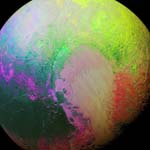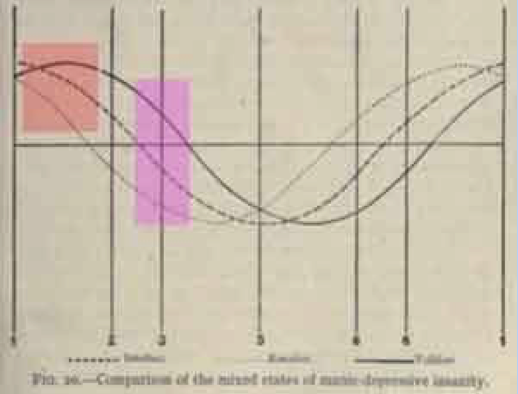
Mood
 THE BIPOLAR SPECTRUM: MIXED STATES
THE BIPOLAR SPECTRUM: MIXED STATES

Where depression meets mania.
by John McManamy

Where depression meets mania.
by John McManamy
THE FOLLOWING is drawn from my book, NOT JUST UP AND DOWN ...
Regarding “mixed states,” as always, Emil Kraepelin, who coined "manic-depression," was onto it first. According to the old master:
Very often, we meet temporarily with states which do not exactly correspond to manic excitement or to depression, but represent a mixture of morbid symptoms … This relationship becomes most clear in the transition periods from one state to another, which often extend over weeks or months.
Depression and mania cycling into each other.
Kraepelin adds another layer of sophistication to this by plotting our cycles in three alternating wave patterns of intellect, emotion, and volition. The diagram below is from his 1921 Manic-Depressive Illness. I have overlaid two colored squares. In the pinkish square, we see the three waves occupying mania, but free-falling into depression. In the purple square, two of the waves have dropped below the “normal” horizon into depression, while one remains above in mania. This represents a mixed state. Where the lines eventually converge at the bottom we have “pure” depression.
Then the pattern repeats in reverse on the cycles’ upward course through mixed states and back into pure mania.

This, Kraepelin explains, is why we may find ourselves in various states of animated despair or funky highs. The old master came up with six different categories of mixed states, which we can simplify (as do others) into agitated depressions and dysphoric manias. For right now, let’s not bother trying to distinguish one from the other. Instead, simply recall that last time you experienced road rage, whether you were in a car or not. That sort of describes it.
Picture yourself, for instance, in Walmart, wanting to run down all the shoppers with your cart, just prior to bursting into tears by the 500-pound bags of dry dog food.
I once fired God. God and I have issues. There’s a passage in Homer’s Iliad that best gives expression to how I was feeling. This is when the Greeks’ mighty warrior, Achilles, discovers that the god Apollo has played a trick on him (in my case, this involved God hiding my car keys just as I needed to head out the door for an important meeting). As Homer describes it: “Achilles of the nimble feet was furious.”
I looked up at the ceiling. “God, you’re fired!” I shouted.
So—this is what a mixed state sort of looks like. As it turned out, a few minutes later, God returned my keys, I settled down, and I got to my meeting on time, without incident. So, technically speaking, I was operating well within the range of “normal,” or normal with hiccups.
SIGN UP FOR MY FREE EMAIL NEWSLETTER
But there have been times in my life where my Homeric sense of distress went on for days on end. “Rage! Goddess, sing the rage,” reads the opening line to the Iliad. Tell me about it.
Kraepelin estimated the frequency of mixed states at 60 percent. More modern estimates (discarding the ones using ridiculously strict criteria) place it anywhere from the 20 to the 70 percent range. In other words, “mixed” may well be our most common mood presentation.
Not that you would know this by flicking through DSMs III through IV. Until the DSM-5 of 2013, a mixed state required the simultaneous presence of both full-blown depression and mania. This effectively made a rarity of mixed states. Introducing into the mix, say, “mixed depressive episode” (depression with some elements of mania) would have made a lie of “polarity.” Imagine having to acknowledge that even “unipolar” depression could contain elements of “bipolar.”
There goes your precious wall of diagnostic separation.
This is the point that the late Greek psychiatrist, Athanasios Koukopoulos makes. Dr Koukopoulos virtually owns the term, “agitated depression.” His argument—which I heard him expound on at length in Pittsburgh at the Fourth International Conference on Bipolar Disorder in 2001—is that unless the DSM expressly red-flags this variant, clinicians will continue to treat all depressions as the same.
Antidepressant down the hatch, in other words, which may only worsen the condition.
Now imagine the mix featuring mania or hypomania as the dominant presentation. Thus instead of experiencing “euphoric” highs, we enter a state of “dysphoric” distress, what Hagop Akiskal refers to as mania’s “dark side.” This might not look all that much different from agitated depression, but if you can get an accurate read on where you are now, you may be able to anticipate where your brain is going next.
As you are by now aware, our entire well-being depends on cultivating an ability to see over the bend in the horizon.
Hagop Akiskal is the one most closely identified with the mood spectrum. Over the years, he has collaborated with an international team of researchers—most notably Olavo Pinto, Elie Hantouche, and the late Franco Benazzi—in teasing out in patient populations elements of mania in depression, and depression in mania. His bottom line is that these patients look very different from those presenting with pure depression or pure mania.
In addition, Dr Akiskal adds another twist to mixed states, one that builds on Kraepelin. As you recall, the old master viewed manic-depression as bleeding over into personality, and he devoted considerable time observing this in his patients. Thus, he noted, manic episodes were far more likely to arise from patients with “manic” temperaments than from those who were naturally down.
“State,” in effect, emerges from “trait.” In this context we can also view the mood spectrum in terms of our illness being an extension of our personalities.Dr Akiskal took this a step farther by asking, in effect, what happens if opposite state meets opposite trait? Say someone who is naturally up who becomes depressed. That depression, he argues, is going to look a lot different than someone who is naturally down to begin with. Can we call it a mixed state? Dr Akiskal does.
By the time the DSM-5 Task Force set to work in 2006, the body of research evidence in favor of mixed states could not be explained away. In addition, at least two of the people on the DSM-5 mood disorders work group had published research articles on mixed states, including Ellen Frank of the University of Pittsburgh and Trisha Suppes of Stanford.So it was—in one of the few things the DSM-5 did right—we find for the first time, on the unipolar side, “depressive disorder with mixed features” (unipolar depression with at least three hypomanic symptoms). Over on the bipolar end, we get, again for the first time, “manic or hypomanic episode with mixed features” (mania or hypomania with at least three depression symptoms), and “depressive episode with mixed features” (depression with at least three manic/hypomanic symptoms).
We can quibble over why the DSM-5 set the criteria at three symptoms rather than two, but the reality is that any clinician who takes stock in counting symptoms is not paying attention to his actual patient. It would have been far more helpful, instead, had the DSM-5 dispensed with the symptom-count entirely and actually told us what we were looking at—agitated depressions and dysphoric manias and hypomanias.
Okay, what about anomalous symptoms, such as a patient laughing while describing her misery? At a session titled “Mixed Features in Depressive Episodes” at the 2015 US Psychiatric and Mental Health Congress in San Diego, I heard a panel of bipolar experts advise the clinicians in the audience to pay attention to such inconsistencies. But what do you call it? What does it signify? Who knows? We’re only just starting to learn.
One final point: Clinicians and researchers frame their discussions in terms of threshold episodes. The reality, though, is we spend a good deal of our time, probably most of it, at the subthreshold level, below the diagnostic radar. Even in “normal,” our psyches are constantly buffeted by the fluctuations of our moods and thoughts and energy levels, typically on mixed collision courses. These disturbances may not merit a clinician’s attention, but far too often they are enough to ruin our day—day after day.
To freely interpret: Even our “normals” can be mixed.
Such is the nature of our cycles, nothing ever standing still, everything in motion. Cycling may well be the elegant and simple explanation for what takes place on the bipolar spectrum, but our mixed states serve as a sobering reminder of what tends to happen when simplicity, with the help of a trickster god or two, builds on itself.
Life suddenly becomes complicated.
Companion articles:
June 23, 2016
NEW!
Follow me on the road. Check out my New Heart, New Start blog.












